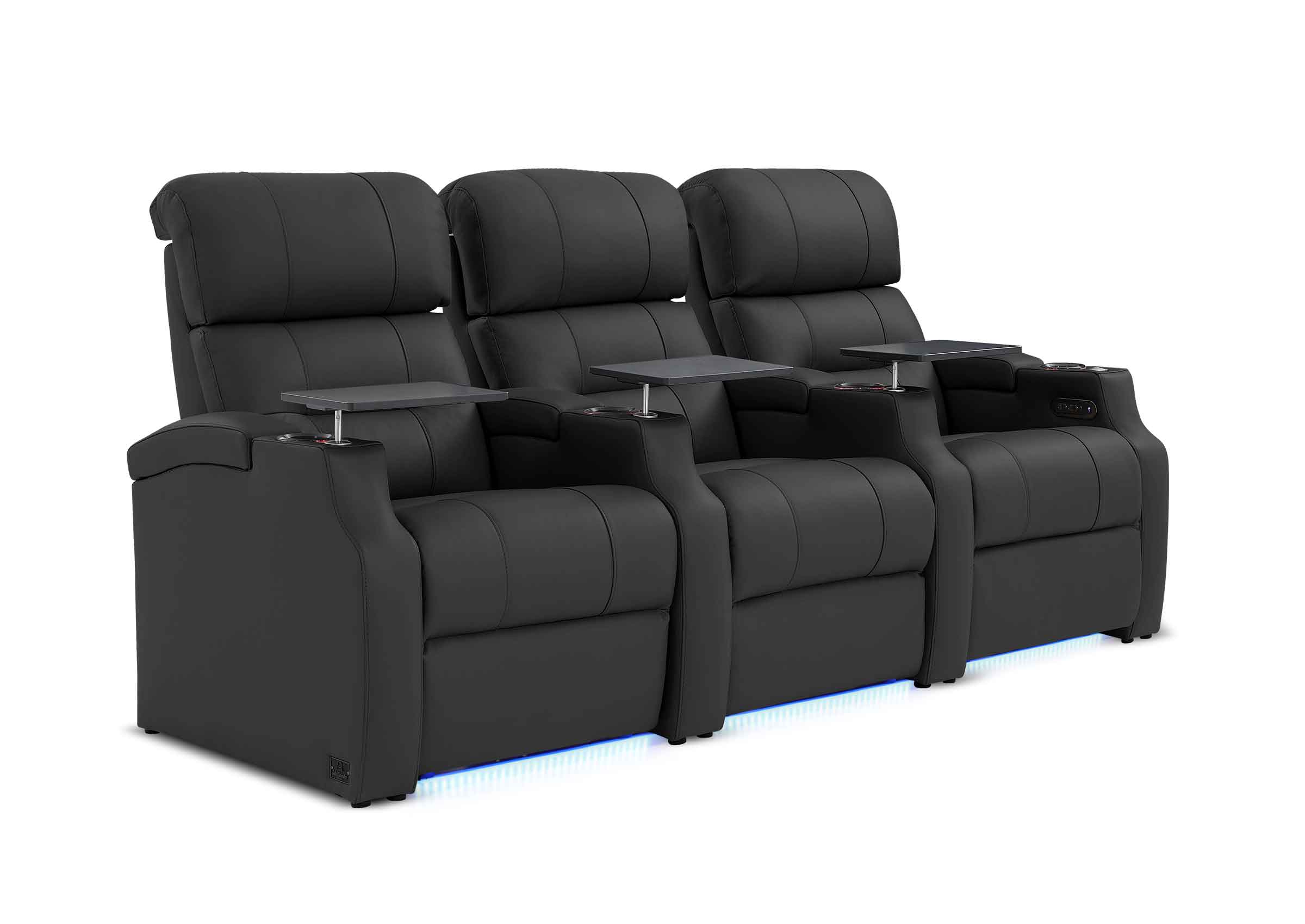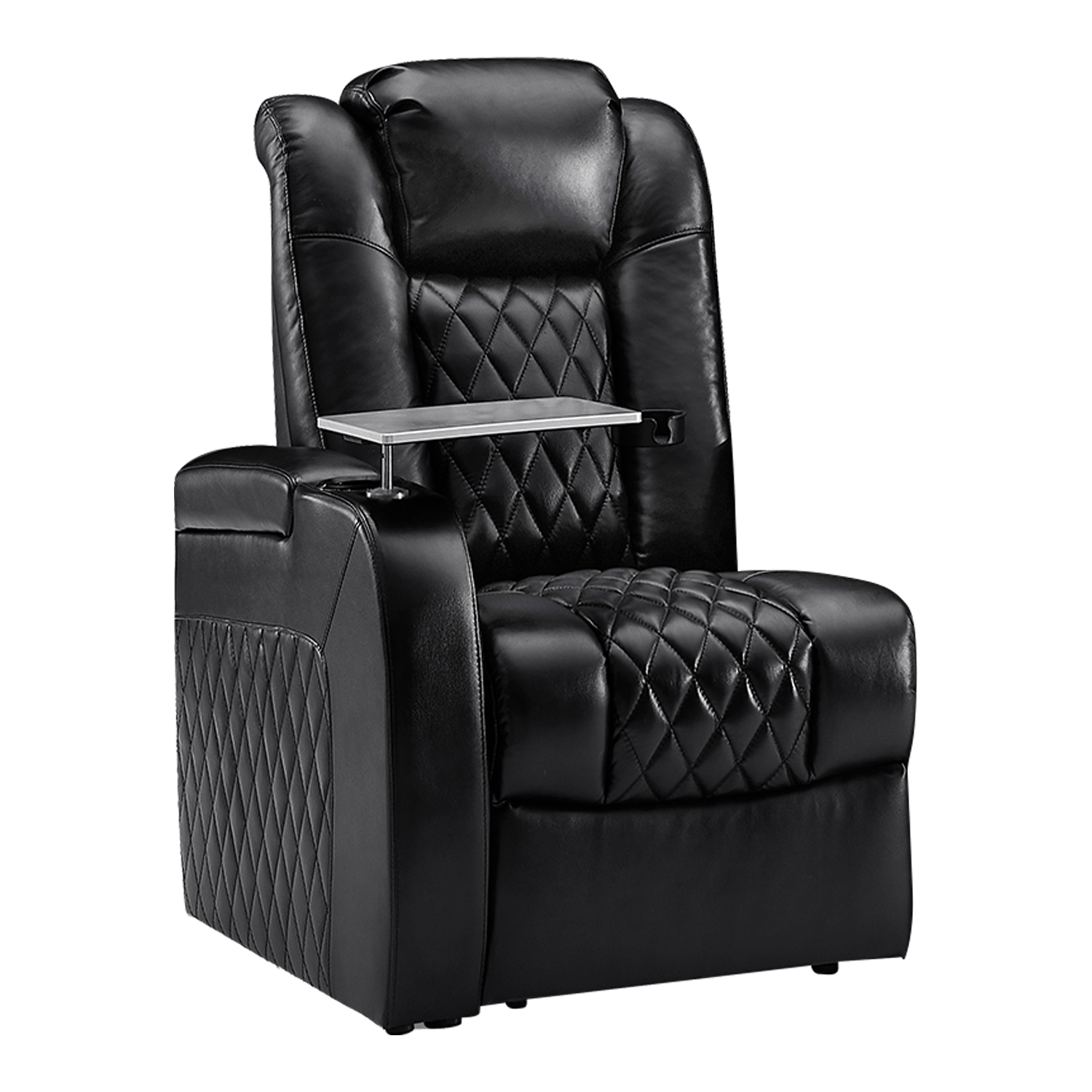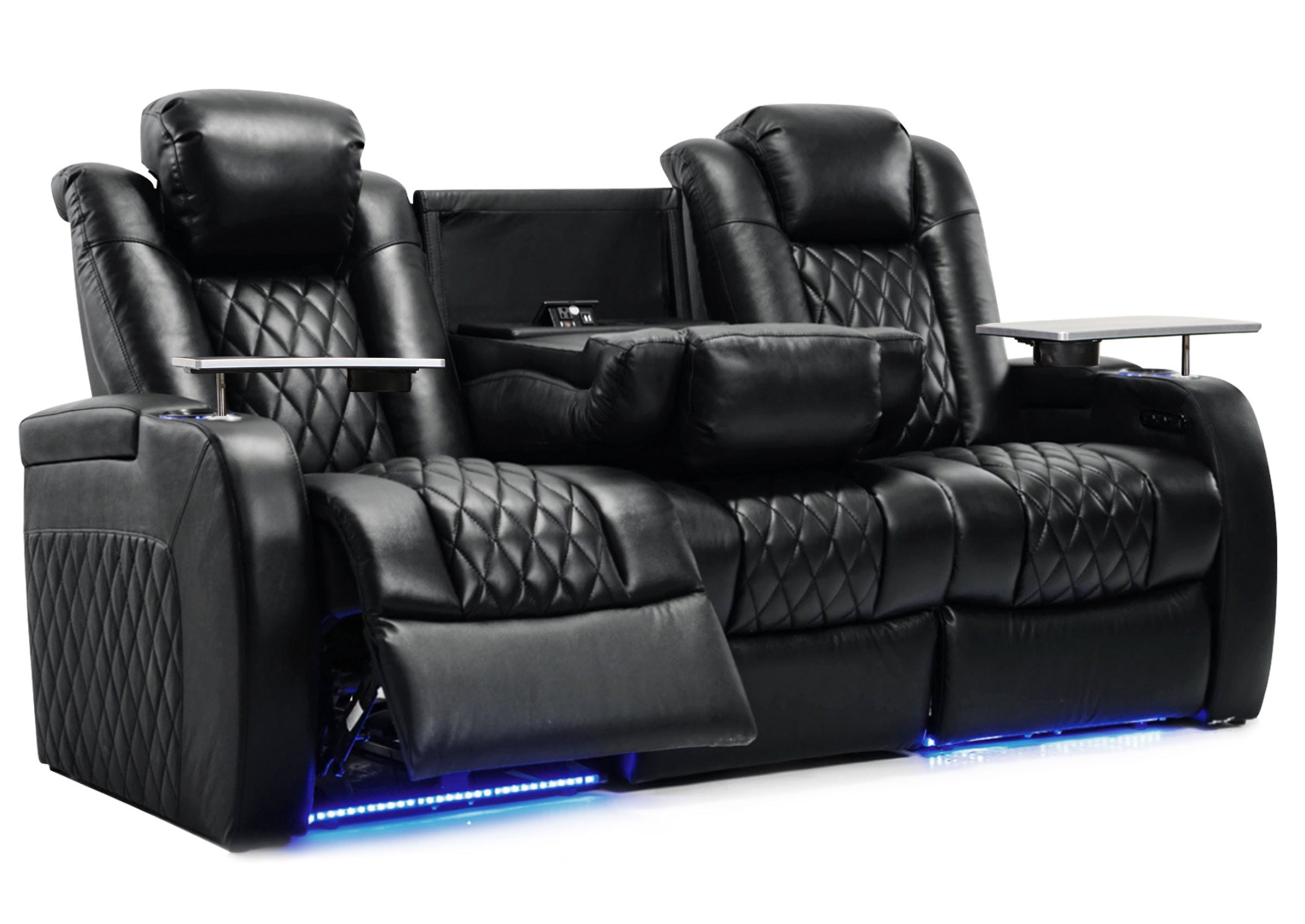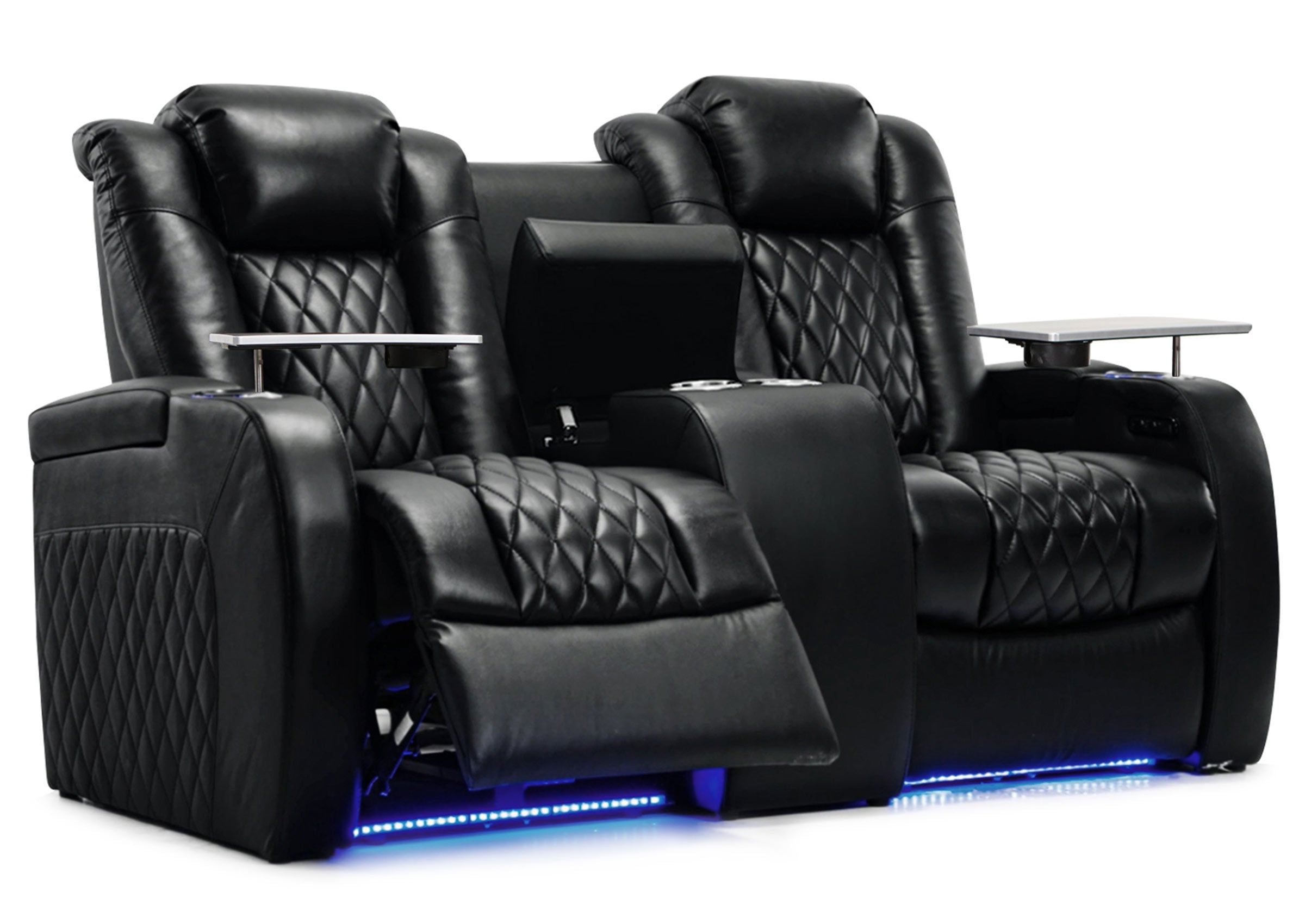If you're buying home theater seating, you'll want to know if the leather is real or fake. There are simple ways to check the material yourself - from looking at the surface patterns to feeling the texture and temperature. Real leather has specific traits that set it apart from synthetic materials, and knowing these differences will help you make a smart purchase. This guide covers the key methods to verify genuine leather and avoid overpaying for imitation products.
1. Check Home Theater Seating by Sight
The most reliable way to identify genuine leather starts with a careful visual examination. The key is to know exactly what natural leather looks like and how it differs from synthetic imitations.
Uneven Colors and Textures
Real leather shows natural variations across its surface. Unlike synthetic materials with perfectly uniform patterns, genuine leather has subtle differences in texture and color. Each piece displays unique characteristics - some areas may be slightly darker or lighter than others. These natural imperfections are actually signs of quality, not flaws.making genuine leather an excellent choice for home theater seating, combining luxury and comfort.
Non-Repeating Grain Patterns
Examine the grain pattern closely. Authentic leather has irregular pores and a non-repeating surface texture. Run your hand over different sections - you should notice slight variations in the grain. Fake leather often shows an identical pattern that repeats every few inches, while real leather's surface remains naturally inconsistent.
Matte Surface Shine
Natural leather has a distinctive way of interacting with light. When you shine light across the surface, genuine leather displays a warm, subtle glow rather than a plastic-like shine. The surface should have a soft, matte finish that diffuses light instead of creating sharp reflections.
Natural Scars and Growth Marks
Look for signs of the leather's natural origin. Real leather may show:
- Small scars or healed marks from the animal's life
- Subtle creases and wrinkles that form naturally
- Slight color variations around natural features
- Areas where the grain pattern shifts or changes
These authentic marks differ from the artificial textures pressed into synthetic materials. While sofa manufacturers might try to imitate these features, natural markings have an organic, random quality that's hard to fake.

2. Test Home Theater Seating by Touch
A hands-on test reveals key differences between real and artificial leather. Real leather of seatings responds to touch in unique ways that synthetic materials can't match.
Touch for Cold Initial Feel
Real leather stays naturally cool to the touch at room temperature. Place your palm flat on the surface - genuine leather should feel cool initially, then quickly warm up to your body temperature. Synthetic materials typically feel room temperature right away and don't have this cooling effect.
Press with Fingers to Test Firmness
Push your fingers gently into the material. Real leather feels naturally soft yet structured. The surface should give slightly under pressure while maintaining its overall form. Good-quality leather has a supple feel that's firm but not stiff, unlike the uniform resistance of synthetic materials. When you press different spots, each area should respond with slightly different levels of softness.
Pinch to Test Shape Recovery
Gently pinch and fold a small section of the material. Genuine leather creates natural creases when folded and springs back to its original shape when released. It will keep a slightly wrinkled texture where pinched, then gradually smooth out over a few minutes. Fake leather, in contrast, often bounces back instantly or stays permanently creased.
Run Fingers Across Surface for Texture
Run your fingers across different areas of the surface. Genuine leather has subtle variations in texture - some spots feel slightly rougher or smoother. The grain pattern creates natural bumps and dips that you can feel clearly. These texture changes should feel random and organic, quite different from the mechanical uniformity of synthetic materials.

3. Smell Home Theater Seating Material
The smell of leather provides another reliable way to check authenticity. Real leather has a natural scent that's hard to duplicate in synthetic materials.
Sniff for Natural Leather Smell
Put your nose close to the material and take a deep breath. Real leather has a rich, natural scent similar to a new leather wallet or shoes. This smell is mild and pleasant, not sharp or overwhelming. Artificial materials often lack this characteristic scent or try to mask their chemical smell with artificial fragrances.
Check for Chemical Odors
Move your nose across different areas of the surface. Fake leather typically gives off hints of plastic, vinyl, or other chemical smells. These artificial scents might be subtle, but they're noticeably different from genuine leather's natural aroma. If you detect any strong chemical smells or artificial perfumes, the material is likely synthetic.
Warm the Surface and Smell Again
Rub a small area briskly with your palm for about 30 seconds to warm it up. Genuine leather's natural scent becomes slightly stronger when warmed, but the basic smell stays the same. Synthetic materials, however, might release stronger chemical odors when heated. This warming test often reveals artificial materials that have been treated with leather-scented sprays.

4. Read Home Theater Seating Labels
Product labels and documentation can reveal crucial details about leather quality. A careful review of these materials helps verify what you're actually buying.
Read Product Labels for Key Terms
Real leather products use specific industry terms. "Full grain" indicates the highest quality, keeping the natural surface of the hide. "Top grain" means the surface has been lightly sanded for consistency. "Genuine leather" is the basic grade of real leather. If these terms are missing from the label, be cautious about the product's authenticity.
Watch for Warning Terms
Several terms signal that a product isn't real leather. "Bonded leather" contains only leather scraps mixed with synthetic materials. "Faux leather," "leatherette," "vinyl," or "vegan leather" are completely synthetic. Some manufacturers use "leather-like" or "leather-look" - these always mean artificial materials.
Review Warranty Coverage
Check what the warranty covers specifically for the leather material. Quality leather furniture typically comes with detailed care instructions and specific warranty terms for the leather itself. Limited coverage or vague terms about material care might indicate lower-quality or synthetic materials.
5. Test Home Theater Seating Movement and Sound Signals
Genuine leather produces specific responses during active use that can help confirm its authenticity.
Press to Check for Creaking
Sit down and shift your weight on the furniture. Real leather makes subtle creaking or rustling sounds as it flexes. These sounds should be soft and natural, similar to a leather jacket or shoes. Synthetic materials often stay silent or make sharp, plastic-like noises when compressed.
Stretch Side to Side
Pull the material gently from both sides. Real leather shows gradual, uneven stretching across its surface. It should resist slightly but give way smoothly without sudden loosening. Synthetic materials tend to either not stretch at all or stretch too easily and uniformly.
Check Multi-Seam Points
Press areas where three or more seams meet. These junction points in real leather should maintain even flexibility without stiff spots. Move the connecting sections in different directions - the material should flex naturally at every angle, while faux leather often shows extra stiffness at these points.
6. Professional Methods to Test Leather Quality
Professional leather experts use specific tests to verify authenticity. These methods can help you make a more thorough assessment before purchasing.
Try the Water Drop Test
Place a small water drop on an inconspicuous area. Real leather absorbs water gradually over several minutes, leaving a slightly darker spot that dries naturally. Synthetic materials repel water completely or let it sit on the surface. Wait five minutes - if the water hasn't soaked in at all, the material is likely artificial.

Inspect Hidden Areas and Backing
Turn over edges or check beneath cushions where possible. Real leather's back side has a distinctive suede-like texture and natural color variations. The backing should feel fibrous and slightly rough. Synthetic materials often have fabric backing or a smooth, uniform underside that looks machine-made.
Study the Stitching Lines
Examine seams and stitched areas closely. Quality leather furniture uses thick, even stitches with strong thread that matches the leather color. The stitching should follow the material's natural stretch points. Look for reinforced seams at stress points - flimsy or irregular stitching often indicates lower quality materials.

Look for Quality Certifications
Search for leather quality certification marks on tags or documentation. Respected leather authorities issue specific certifications. These marks should include the certifying body's name and registration numbers. Quality manufacturers proudly display these credentials, while their absence might signal questionable materials.
Make Sure You're Buying Genuine Leather Seating!
Before buying leather home theater seats, take a few minutes to check the material carefully. Use your eyes to spot natural patterns, your hands to feel the texture and temperature, and your nose to detect real leather scent. Read product labels closely and test how the material moves. Real leather always shows natural variations while fake leather looks and feels too uniform. These quick checks will help you avoid overpaying for synthetic materials.


































